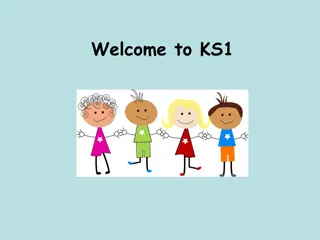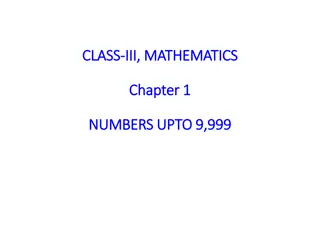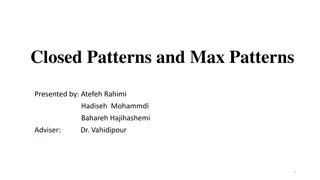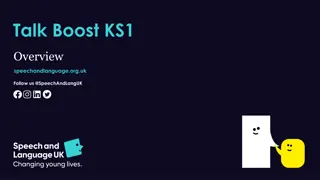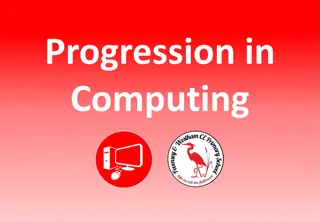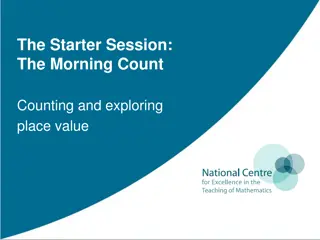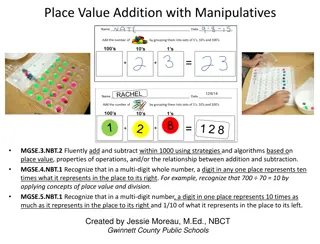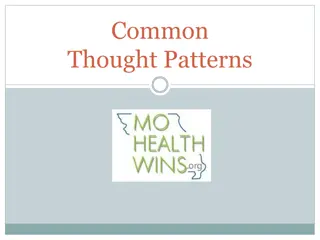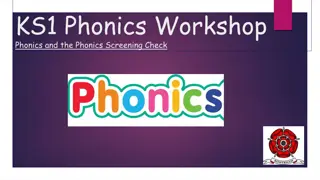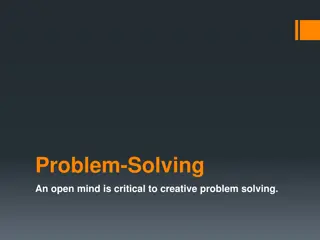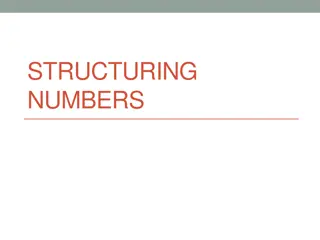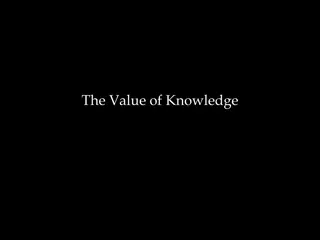Understanding Number Patterns and Place Value for KS1 Problem-Solving
In this educational material, students explore near doubles, understanding how numbers relate to each other in terms of place value. By doubling numbers close to each other, they enhance their problem-solving skills. Through examples like double 3 being 6 and double 5 being 10, students grasp the concept easily. The visuals provided aid in a better understanding of these mathematical concepts, helping young learners build a solid foundation in math.
Download Presentation

Please find below an Image/Link to download the presentation.
The content on the website is provided AS IS for your information and personal use only. It may not be sold, licensed, or shared on other websites without obtaining consent from the author. Download presentation by click this link. If you encounter any issues during the download, it is possible that the publisher has removed the file from their server.
E N D
Presentation Transcript
Part 1 Task D: Near doubles This is 3 NUMBER AND PLACE VALUE I SEE PROBLEM-SOLVING KS1
Part 1 Task D: Near doubles Double 3 is 6 3+3 = 6 NUMBER AND PLACE VALUE I SEE PROBLEM-SOLVING KS1
Part 1 Task D: Near doubles This is 5 NUMBER AND PLACE VALUE I SEE PROBLEM-SOLVING KS1
Part 1 Task D: Near doubles Double 5 is 10 5+5 = 10 NUMBER AND PLACE VALUE I SEE PROBLEM-SOLVING KS1
Part 1 Task D: Near doubles This is 4 NUMBER AND PLACE VALUE I SEE PROBLEM-SOLVING KS1
Part 1 Task D: Near doubles Double 4 is 8 4+4 = 8 NUMBER AND PLACE VALUE I SEE PROBLEM-SOLVING KS1
Part 1 Task D: Near doubles This is 6 NUMBER AND PLACE VALUE I SEE PROBLEM-SOLVING KS1
Part 1 Task D: Near doubles Double 6 is 12 6 +6 = 12 NUMBER AND PLACE VALUE I SEE PROBLEM-SOLVING KS1
Part 1 Task D: Near doubles This is 9 NUMBER AND PLACE VALUE I SEE PROBLEM-SOLVING KS1
Part 1 Task D: Near doubles Double 9 is 18 9 +9 = 18 NUMBER AND PLACE VALUE I SEE PROBLEM-SOLVING KS1
Part 1 Task D: Near doubles This is 7 NUMBER AND PLACE VALUE I SEE PROBLEM-SOLVING KS1
Part 1 Task D: Near doubles Double 7 is 14 7 +7 = 14 NUMBER AND PLACE VALUE I SEE PROBLEM-SOLVING KS1
Part 2 Task D: Near doubles I know so 3+3 = 6 NUMBER AND PLACE VALUE I SEE PROBLEM-SOLVING KS1
Part 2 Task D: Near doubles I know so 3+3 = 6 4+3 = 7 NUMBER AND PLACE VALUE I SEE PROBLEM-SOLVING KS1
Part 2 Task D: Near doubles I know so 3+3 = 6 4+3 = 7 NUMBER AND PLACE VALUE I SEE PROBLEM-SOLVING KS1
Part 2 Task D: Near doubles I know so 5+5 = 10 NUMBER AND PLACE VALUE I SEE PROBLEM-SOLVING KS1
Part 2 Task D: Near doubles I know so 5+5 = 10 5+4 = 9 NUMBER AND PLACE VALUE I SEE PROBLEM-SOLVING KS1
Part 2 Task D: Near doubles I know so 5+5 = 10 5+4 = 9 NUMBER AND PLACE VALUE I SEE PROBLEM-SOLVING KS1
Part 2 Task D: Near doubles I know so 6+6 = 12 NUMBER AND PLACE VALUE I SEE PROBLEM-SOLVING KS1
Part 2 Task D: Near doubles I know so 6+6 = 12 7+6 = NUMBER AND PLACE VALUE I SEE PROBLEM-SOLVING KS1
Part 2 Task D: Near doubles I know so 6+6 = 12 7+6 = 13 NUMBER AND PLACE VALUE I SEE PROBLEM-SOLVING KS1
Part 2 Task D: Near doubles I know so 7+7 = 14 NUMBER AND PLACE VALUE I SEE PROBLEM-SOLVING KS1
Part 2 Task D: Near doubles I know so 7+7 = 14 7+6 = NUMBER AND PLACE VALUE I SEE PROBLEM-SOLVING KS1
Part 2 Task D: Near doubles I know so 7+7 = 14 7+6 = 13 NUMBER AND PLACE VALUE I SEE PROBLEM-SOLVING KS1
Part 1 Task E: Bordering 10 9+3 NUMBER AND PLACE VALUE I SEE PROBLEM-SOLVING KS1
Part 1 Task E: Bordering 10 Split 3 into 1 and 2 9+3 NUMBER AND PLACE VALUE I SEE PROBLEM-SOLVING KS1
Part 1 Task E: Bordering 10 Split 3 into 1 and 2 9+3=12 NUMBER AND PLACE VALUE I SEE PROBLEM-SOLVING KS1
Part 1 Task E: Bordering 10 7+4 NUMBER AND PLACE VALUE I SEE PROBLEM-SOLVING KS1
Part 1 Task E: Bordering 10 Split 4 into 3 and 1 7+4 NUMBER AND PLACE VALUE I SEE PROBLEM-SOLVING KS1
Part 1 Task E: Bordering 10 Split 4 into 3 and 1 7+4=11 NUMBER AND PLACE VALUE I SEE PROBLEM-SOLVING KS1
Part 1 Task E: Bordering 10 8+5 NUMBER AND PLACE VALUE I SEE PROBLEM-SOLVING KS1
Part 1 Task E: Bordering 10 Split 5 into 2 and 3 8+5 NUMBER AND PLACE VALUE I SEE PROBLEM-SOLVING KS1
Part 1 Task E: Bordering 10 Split 5 into 2 and 3 8+5=13 NUMBER AND PLACE VALUE I SEE PROBLEM-SOLVING KS1
Part 2 Task E: Bordering 10 Spot the mistake For 8+4, split 4 into and 8+4= NUMBER AND PLACE VALUE I SEE PROBLEM-SOLVING KS1
Part 2 Task E: Bordering 10 Spot the mistake 1 3 For 8+4, split 4 into and 8+4=13 NUMBER AND PLACE VALUE I SEE PROBLEM-SOLVING KS1
Part 2 Task E: Bordering 10 Correct answer: 2 2 For 8+4, split 4 into and 8+4=12 NUMBER AND PLACE VALUE I SEE PROBLEM-SOLVING KS1




